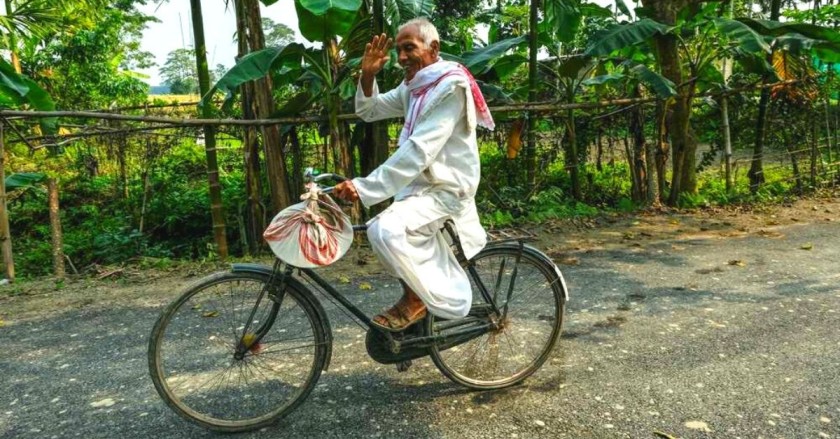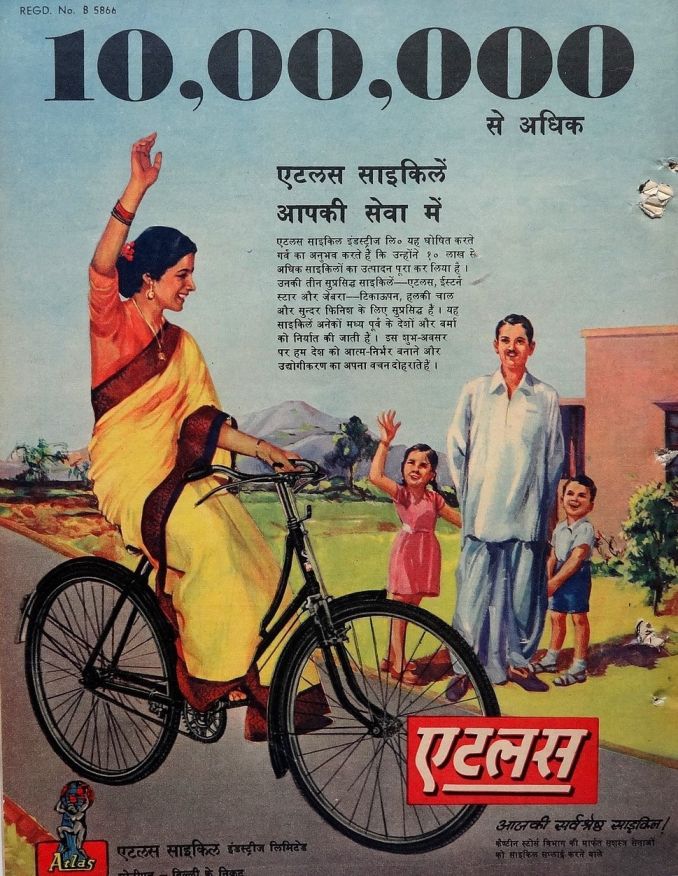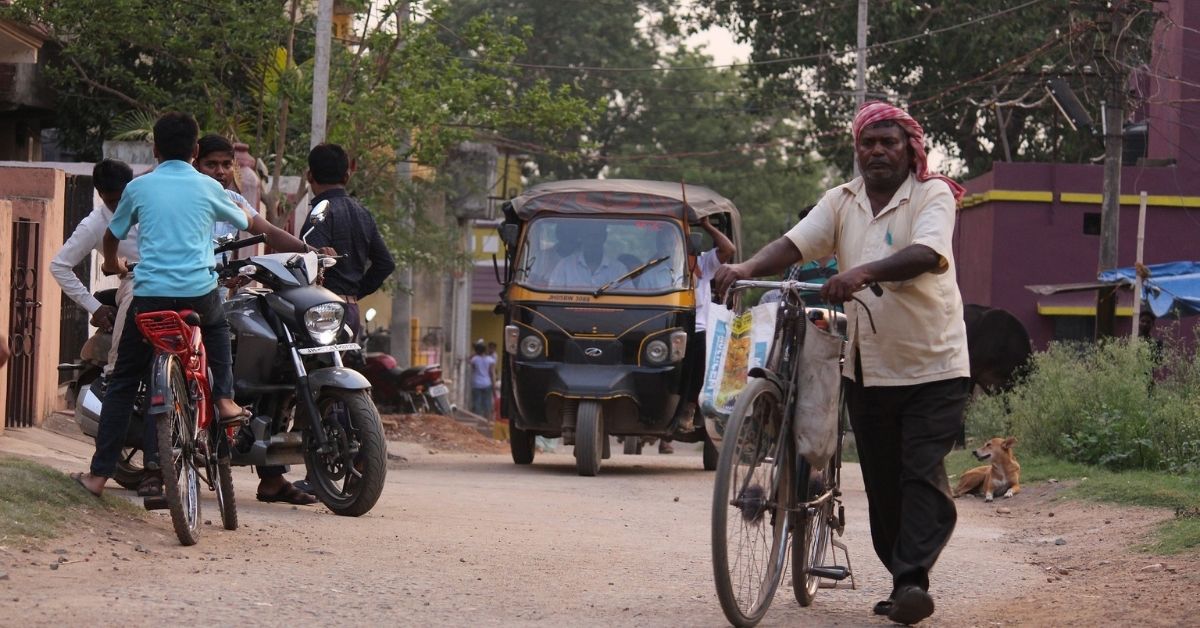Born in a Tin Shed, Swadeshi ‘Atlas’ Became India’s Largest Cycle Manufacturer by 1965
Atlas Cycles Ltd was established by Janki Das Kapur in a small shed in Haryana to make affordable cycles for all and became a well-known brand in international markets as well.

“Atlas Cycles is proud to announce that it has achieved production of 10,00,000 cycles…These cycles are known for being sustainable, light speed and fine finishing. We are exporting cycles to Burma and the Middle East Countries. On this occasion, we reiterate our pledge to make the country self-reliant and industrialised.”
This message on a coloured poster created a stir in the advertising industry and middle-income households in 1961. It was far from a regular cycle ad as it had a sari-clad woman riding it. She is seen happily waving at her husband and two children.

The company had just completed 10 years and recorded a path-breaking production record. Carrying forward the spirit of shattering glass ceilings, they addressed two misconceptions in a dignified way.
One was, of course, the gender stereotype that women always sat behind the man on the cycle. It was probably for the first time that a woman was not shown advertising a domesticated product like detergent or masalas. The other one denoted cycle’s comfort level by showing it can accommodate any attire, in this case, a sari.
“I remember seeing the ad and telling my grandfather to purchase the cycle that the model sat on. Finally, there was a cycle for women I thought,” recalls my aunt, Sapna Chauhan, whose first cycle was the Atlas.
It would be safe to say that like Sapna, Atlas Cycles proved to be an integral part of all our childhoods. Nostalgia factor aside, the affordable pricing made the company a common man’s go-to transportation mode, both in the rural and urban areas.
Unfortunately, the cycle that became a symbol of inheritance, had the most tragic shutdown amidst the global COVID-19 pandemic. Ironically, its last manufacturing unit in Sahibabad shut on June 3, which happens to be World Bicycle Day.
Citing a lack of funds to run the factory, CEO, N.P. Singh Rana, labelled it as a ‘temporary’ closure till they can raise around Rs 50 crore. As the disheartening news of India’s iconic brand shutting down came to the fore, thousands of people shared their fond memories with the humble cycle on various social media platforms.
As many hope and pray that the company peddles their way back into our lives, we trace the history of this humble commuting option.
A Tale That Began In A Shed

Late Janki Das Kapur from Haryana was the man behind giving India an affordable cycle and creating uncountable memories.
But did you know that the company which once boasted of being the number one cycle production company had a modest beginning?
Kapur established Atlas Cycle Industries (ACIL) in 1951 inside a shed in Sonepat, Haryana. For the next year, he worked rigorously and produced the first bicycle in 1952. In the same year, he set up his first factory complex sprawling 25-acres. The factory produced 12,000 cycles in the very first year and there was no looking back.
In 1958, Atlas made its debut in the international market and since then it has exported to several countries including the Middle East, Myanmar and South Africa. In 2004, the company exported to 50 countries, with a dealer network of 4,000 in the domestic market.
The staggering sales increased the market share of Atlas and made them one of the largest cycle manufacturing players in India.
Diversification & Downfall

Under Kapur’s futuristic vision, Atlas Cycles experimented and innovated year-after-year to cater to people from all arenas. He knew in developing India, the cycle would be a viable accessory for everyone, from a milkman to economics Nobel laureate Amartya Sen. Yes, Sen’s bicycle, which he used for his fieldwork in West Bengal, is displayed at Nobel Museum in Stockholm, Sweden.
In the beginning, Kapur kept the cycle models basic, ones that would help millions move from one place to another. Once Atlas became a household name, they introduced the ‘Rebel’ cycle that was marketed as an adventure bike. Next, came the Atlas Concorde that had 10 gears. In 1978, Atlas launched India’s first racing cycle, a stint that made them the official supplier of bicycles for the Delhi Asian Games in 1982.
To accommodate the mounting operations, he set up more units in Sahibabad, Rasoi and Gurugram. Its combined manufacturing capacity stood at a hefty 40 lakh cycles per annum in 2020.
Surviving cut-throat competition with both domestic and international players in the market was anything but easy. As decades passed, the purchasing power of the common man rose and a middle-class household was able to afford a car or at most a bike.
The first wave of trouble hit in the early 2000s with family feuds. The company split into three divisions between the third generation Kapurs, each getting a fraction of the management and marketing zone. They even roped in actor Sunil Shetty, tennis star Sania Mirza and Olympic gold medalist Abhinav Bindra to endorse the cycle.
The next blow came 10 years later with the shutdown of Malanpur plant in Madhya Pradesh. The Sonepat plant followed the same route and closed down in 2018. And the looming pandemic was the final nail in the coffin.
Despite the tragic market fall, Rana hopes to revive the company once it succeeds in raising crores after selling surplus land. “Demand is not a problem; the market is very good. We have a very strong dealer and supplier base. We are a 70-year-old brand and very well accepted in the market. We will bounce back,” Rana said in an interview with PTI on 5 June 2020.

Whether or not Atlas Cycles will make a comeback in our lives in the foreseeable future is something that one will have to wait and see. Until then, we can all be grateful for Janki Das Kapur for introducing the possibility of owning a vehicle for every class into a reality in India.
(Edited by Yoshita Rao)
If you found our stories insightful, informative, or even just enjoyable, we invite you to consider making a voluntary payment to support the work we do at The Better India. Your contribution helps us continue producing quality content that educates, inspires, and drives positive change.
Choose one of the payment options below for your contribution-
By paying for the stories you value, you directly contribute to sustaining our efforts focused on making a difference in the world. Together, let’s ensure that impactful stories continue to be told and shared, enriching lives and communities alike.
Thank you for your support. Here are some frequently asked questions you might find helpful to know why you are contributing?


This story made me
-
97
-
121
-
89
-
167













